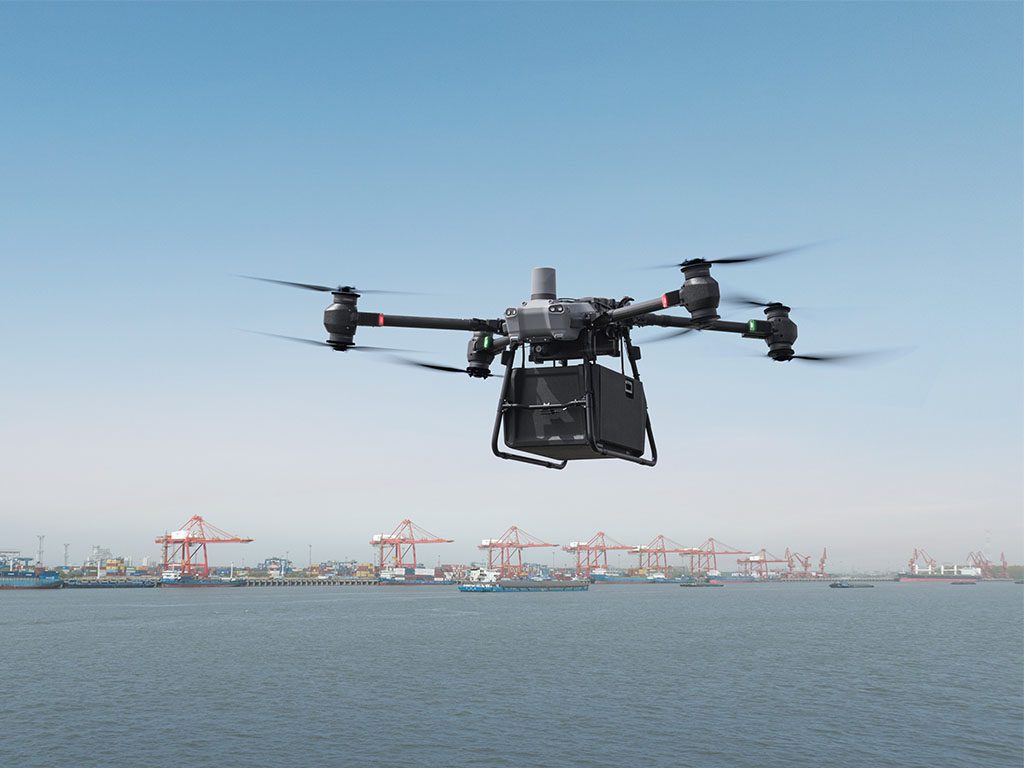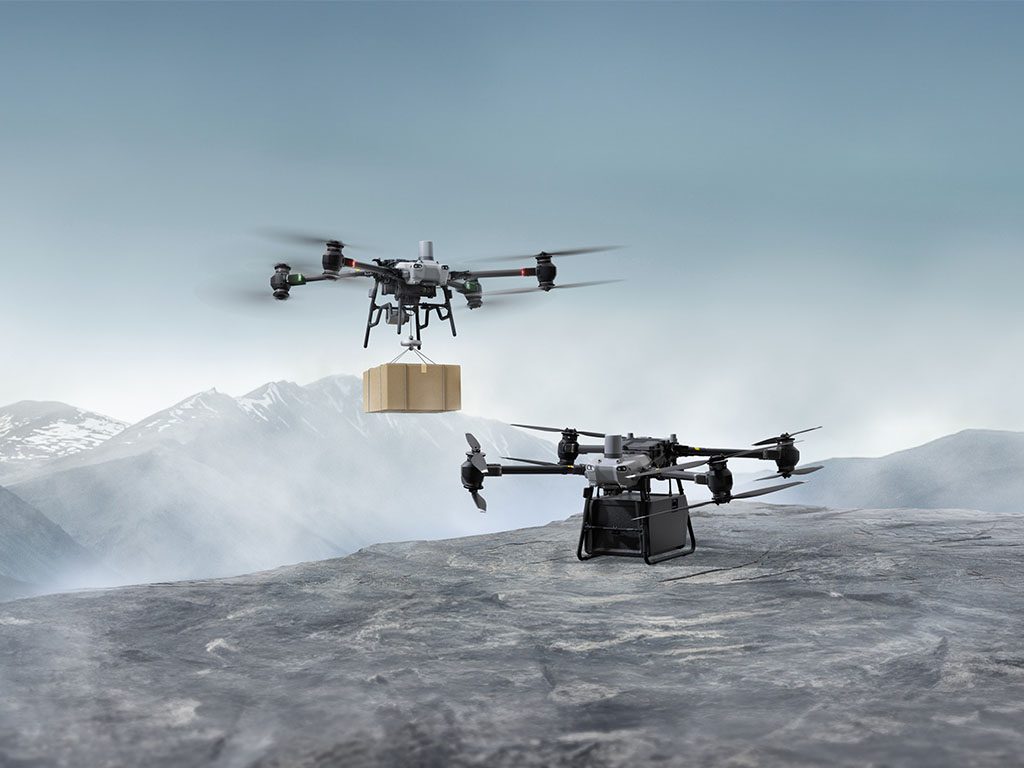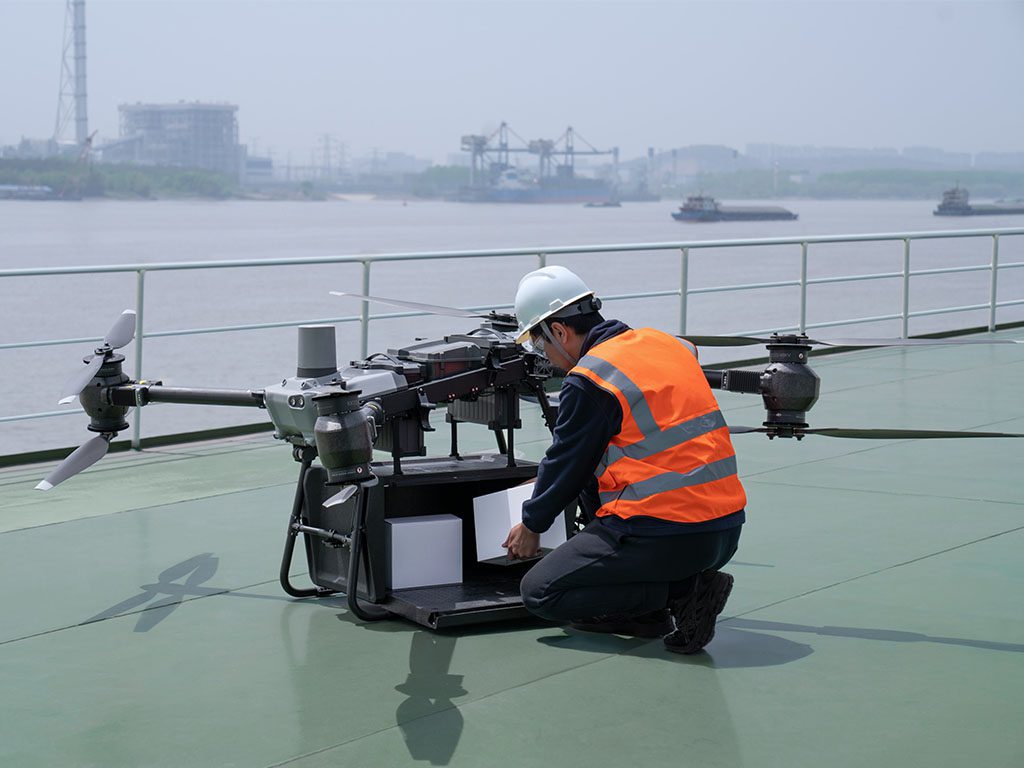Introducing the delivery drone

The DJI FlyCart 30 is a revolution in drone delivery. Designed by DJI, world leader in drone technology, the FlyCart 30 is a heavy-duty, long-distance delivery drone. It has features that go beyond traditional logistical limits, offering a safe, efficient and cost-effective air transport solution.
This innovation marks DJI’s official entry into the drone delivery market, paving the way for a new way of using drones in today’s world. The DJI FlyCart 30 stands out for its powerful signal and optimum intelligence, enabling it to meet the challenges of traditional transport.
What’s more, this professional drone is equipped with dual-battery technology, giving it impressive autonomy for fast, reliable deliveries. It features a multi-rotor configuration with 4 axes and 8 propellers, enabling it to handle large loads in complete safety.
Lifting and transport capabilities
The lifting capacity of the DJI FlyCart 30 is optimized by its robust design and advanced technology. It can carry a load of up to 30 kg, making it ideal for delivering large parcels or a variety of goods.
Its transport mode can be adjusted to suit the specific needs of each mission: Cargo mode is perfect for heavy loads, while Winch mode can be used to load and unload objects in difficult environments where landing may be impossible or dangerous.
With an image transmission range of up to 20 km, the DJI FlyCart 30 offers operators great flexibility in supervising delivery operations. And with a maximum flight speed of 20 m/s and a cruising speed of 15 m/s, it ensures fast, efficient deliveries.
Range and maximum speed
Theautonomy of the DJI FlyCart 30 varies according to the weight of the load carried and the type of battery used. Empty and with two batteries, the drone can fly for 29 minutes. When carrying a maximum load of 30 kg, its autonomy drops to 18 minutes. In single battery mode, autonomy is reduced to 8 minutes. In terms of maximum speed, the DJI FlyCart 30 can reach up to 72 km/h, with a cruising speed of 54 km/h. It can fly at a constant speed of 20 m/s, or around 72 km/h.
What’s more, this delivery drone can cover a maximum distance of 28 km without a load and 16 km with a 30 kg load. These values were obtained under optimum conditions, with no wind and at a temperature of 25°C. In practice, autonomy and range may vary according to factors such as weather conditions, temperature and altitude.
Finally, it’s important to note that the DJI FlyCart 30 can withstand winds of up to 12 m/s during take-off and landing.
Cargo mode: an optimal transport solution


The Cargo mode of the DJI FlyCart 30 offers an optimized air transport solution for heavy loads. The goods are placed in a specially designed suitcase, fitted with sensors to improve the aircraft’s balance in flight.
- The cargo box allows rapid unloading and automatic weighing of transported loads.
- This option is particularly suitable for transporting an object from point A to point B without the need for a landing site.
- This solution effectively solves traditional transport problems, offering a safe, economical and fast delivery method.
Cargo mode breaks new ground in drone delivery, enabling heavier loads to be transported over longer distances.
Multi-level redundancy for enhanced safety
Safety is a crucial aspect of the DJI FlyCart 30, and this is reflected in its multi-level redundancy system. In the event of failure of one of the components, the drone can continue to operate optimally thanks to a backup system. Dual power supply is an example of this redundancy: if one battery fails, the second takes over to ensure the drone’s safe flight and return.
In addition to this redundant power supply, the FlyCart 30 is equipped with other back-up systems for enhanced safety. For example, in the event of signal loss, the drone is programmed to automatically return to its starting point. In addition, an obstacle avoidance system based on two radars and cameras helps prevent collisions.
The DJI FlyCart 30 also features a parachute system that deploys automatically in the event of a major failure, ensuring a controlled descent and minimizing potential damage.
Detailed technical specifications
Visit DJI FlyCart 30 has dimensions of 1,590 x 1,900 x 947 mm (L x W x H) with arms extended and propellers folded, and 2,800 x 3,085 x 947 mm (L x W x H) with arms and propellers extended. It weighs 42.5 kg without battery and 65 kg with two DB2000 batteries. Maximum take-off weight is 95 kg.
It is equipped with several obstacle detection systems, combining optical cameras, infrared detectors and dual radar. Rear detection distance is from 1.5 to 50 m. The front field of view is 360° horizontal, ±45° vertical and ±45° upwards. The rear field of view is ±45° horizontal and 360° vertical.
The drone is water-resistant up to IP55 and can fly even in light rain.
It has a flight autonomy of around 20 minutes on a full charge. The maximum load capacity is 40 kg, enabling goods to be transported from point A to point B safely and efficiently.
The drone features DJI O3 video transmission, covering distances of up to 20 km. It features a four-antenna transmitter system that intelligently selects the optimum antenna for signal transmission, enhancing anti-interference capabilities.
FIELDS OF APPLICATION


The DJI FlyCart 30 is the solution of choice for a wide range of applications, beyond simple parcel delivery.
- Parcel delivery: Its lifting capacity and technical features make it ideal for delivering heavy parcels over long distances.
- Freight transport: In addition to parcel delivery, the DJI FlyCart 30 can be used for general freight transport, especially in hard-to-reach areas.
- SORA experiments: Although French legislation currently restricts the transport of goods by air, the DJI FlyCart 30 can be used for SORA (Specific Operating Risk Assessment) experiments.
- Relief operations: In the event of emergencies or natural disasters, the DJI FlyCart 30 can be used to transport relief supplies or medical equipment.
- Mountain and offshore transport: Thanks to its robustness and ability to withstand a wide range of weather conditions, the DJI FlyCart 30 can be used to transport goods in the mountains or offshore.
With these fields of application, the DJI FlyCart 30 is a versatile tool for a wide range of transport and logistics needs.
Prices and purchase options
The DJI FlyCart 30 is available for pre-order here. The package includes the drone itself, as well as the RC Plus radio control, a smart flight battery and a charging hub with cable.
It should be noted that the purchase of the DJI Flycart 30 offers two delivery options:
- The basic version, Carrier mode, allows goods to be transported in a specially designed crate.
- The mode Retractable winch which is available separately, enables goods to be delivered via a drop winch.
Possibility of adding a drone camera
The DJI FlyCart 30 offers the option of adding a drone camera to enhance its functionality. The FPV (First Person View) camera, for example, provides a real-time view of the drone’s flight, facilitating piloting and precise deliveries. This camera is mounted on the drone’s front frame, and its video feedback is displayed in the DJI Pilot 2 application.
The addition of a drone camera can also bring safety benefits. For example, aiming assistance via the FPV camera can be used for precise parcel drop-off. What’s more, some cameras can be equipped with an anti-oscillation feature to keep the drone stable, even in the event of sudden movements or difficult flying conditions.
